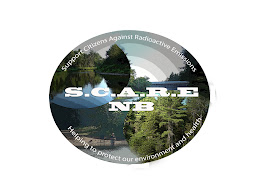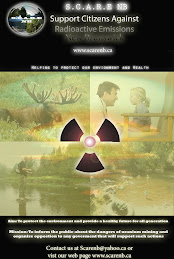THE YELLOW MONSTER(14 Mins) dir. Vicki Lesley
"Through the experiences of 3 ordinary people, we examine the way the Navajo Indians have been treated by the uranium industry over the last 6 decades, uncovering a culture of secrecy, environmental pollution and lasting health impacts. While the Navajos continue to fight for recognition of the legacy of the past, a new generation of mining now looms over them as the nuclear industry seeks to reassert itself as a clean energy source for the 21st century".
http://www.tennerfilms.com/tenner/yellow_monster.html
Friday, December 7, 2007
Tuesday, November 27, 2007
Hot and bothered - INCO vs Moncton
Here's what the "THIS MAGAZINE" had to say about the Moncton resolution. New Brunswick is apparently "Open For Business!"
http://www.thismagazine.ca/issues/2007/11/hotandbothered.php
Another good read is found toward the bottom of the page at http://www.minesandcommunities.org/Action/press1683.htm
called "Reject uranium mining hazard". This piece dicsusses a phone-in session with Premier Graham from Fredericton, on a local radio show. What you read MAY surprise you!
http://www.thismagazine.ca/issues/2007/11/hotandbothered.php
Another good read is found toward the bottom of the page at http://www.minesandcommunities.org/Action/press1683.htm
called "Reject uranium mining hazard". This piece dicsusses a phone-in session with Premier Graham from Fredericton, on a local radio show. What you read MAY surprise you!
Do you want to drink contaminated water?
"In New Brunswick, about 40% of the population obtain their water supply from surface watersheds. That is, an area of land that drains a system of streams, lakes and rivers. One contaminated watershed can mean undrinkable water for thousands of people" (http://www.gnb.ca/0009/0371/0004/0001-e.asp).
________________________________________
An excellent factsheet from the Pembina Institute. This factsheet is a part of a series based on the findings of the Pembina Institute's groundbreaking analysis of the lifecycle impacts of nuclear power in Canada
http://pubs.pembina.org/reports/ClearingAir_UraniumMining.pdf
"Because of their hazardous nature, uranium mine tailings and waste rock require
perpetual care. Operating and now-closed uranium tailings management facilities
have been associated with severe pollution of surface and ground water" (Pembina Institute).
________________________________________
An excellent factsheet from the Pembina Institute. This factsheet is a part of a series based on the findings of the Pembina Institute's groundbreaking analysis of the lifecycle impacts of nuclear power in Canada
http://pubs.pembina.org/reports/ClearingAir_UraniumMining.pdf
"Because of their hazardous nature, uranium mine tailings and waste rock require
perpetual care. Operating and now-closed uranium tailings management facilities
have been associated with severe pollution of surface and ground water" (Pembina Institute).
This is an interesting read.
Healthy Environment, Healthy Canadians Series, Report No. 1 A report prepared for the David Suzuki Foundation Revised January 2007.
http://www.davidsuzuki.org/files/SWAG/DSF_Radon_Report_revised-Jan-07pdf.pdf
http://www.davidsuzuki.org/files/SWAG/DSF_Radon_Report_revised-Jan-07pdf.pdf
Saturday, November 24, 2007
Terms and definitions that are helpful
Genotoxic
A term used to describe toxic agents that can cause mutations in genes (DNA). Known genotoxins include X-rays and other forms of radiation, some synthetic chemicals, and viruses. Since genes are passed down to the next generation, the damage induced by genotoxins can be inherited.
Mutations
Sudden changes in the genetic material of a cell. Mutations occur naturally at a low rate but may increase as a result of radiation, some chemicals, and viruses. Some mutations are beneficial but the majority of mutations are harmful.
Radiation
A stream of particles, alpha, beta, and/or gamma particles, from a radioactive source like X-ray or uranium.
Uranium
A radioactive element and is the mineral uraninite which also contains radium, thorium, polonium, lead and helium.
Plutonium-239, Radium-224, Radium-226, Radium- 228, Radon-222 and Thorium-232 and their decay products
These are classified as known carcinogens by the International Agency for Research on Cancer (IARC). X-rays and gamma radiation are also classed as known carcinogens by the IARC.
Half-life
The time it takes for half of the original radioactive material to transform into daughter products, which may or may not be radioactive.
Radium-226
Has a half-life of 1602 years
Radon-222
A radioactive gas. It is one of the decay products of radium 226. Radon occurs naturally particularly in the areas underlain by granite. In 2007, Health Canada changed the exposure action level for radon on “normal occupancy areas” from 800Bq/m3 to 200Bq/m3.
A term used to describe toxic agents that can cause mutations in genes (DNA). Known genotoxins include X-rays and other forms of radiation, some synthetic chemicals, and viruses. Since genes are passed down to the next generation, the damage induced by genotoxins can be inherited.
Mutations
Sudden changes in the genetic material of a cell. Mutations occur naturally at a low rate but may increase as a result of radiation, some chemicals, and viruses. Some mutations are beneficial but the majority of mutations are harmful.
Radiation
A stream of particles, alpha, beta, and/or gamma particles, from a radioactive source like X-ray or uranium.
Uranium
A radioactive element and is the mineral uraninite which also contains radium, thorium, polonium, lead and helium.
Plutonium-239, Radium-224, Radium-226, Radium- 228, Radon-222 and Thorium-232 and their decay products
These are classified as known carcinogens by the International Agency for Research on Cancer (IARC). X-rays and gamma radiation are also classed as known carcinogens by the IARC.
Half-life
The time it takes for half of the original radioactive material to transform into daughter products, which may or may not be radioactive.
Radium-226
Has a half-life of 1602 years
Radon-222
A radioactive gas. It is one of the decay products of radium 226. Radon occurs naturally particularly in the areas underlain by granite. In 2007, Health Canada changed the exposure action level for radon on “normal occupancy areas” from 800Bq/m3 to 200Bq/m3.
10 Things You Should Know About Uranium Mining
1.“Exploration crews searching for uranium will receive radiation exposure from uranium and its associated radioactive decay products in the drill core cuttings” (Radiation Protection Guidelines for Uranium Exploration. Saskatchewan Labour Department, Occupational Health and Safety Division: http://www,labour.gov.sk.ca/safety).
2. “Whether or not [uranium] mining is conducted in open pits or underground, there are environmental health hazards and impacts to workers and the general public that need to be considered. These include radiation hazards from radon gas, radium, thorium, and non-radioactive contamination from dust and heavy metals such as arsenic, lead, and nickel” (Health Canada, Environment and workplace health. Canadian Handbook on Health Impact Assessment. Volume 4, Chapter 5.4 Uranium Mining. http://hc-sc.gc.ca/ewh-semt).
3. Radiation is one of the few exposures for which the cause-effect relationship with childhood leukemia has been established (Belson et al. 2007). Children are 20% more sensitive to radioactivity because their cells are actively dividing.
4. Uranium mining creates risks to workers and the community in several ways: through radioactive dust and radon released from exploring, milling, and tailing piles. (Stephens and Ahern 2001. institute for Environment and Development. World Business Council for Sustainable Development)
5. Uranium enters the body by ingestion or inhaling airborne uranium – contain dust particles or aerosols. Uranium is absorbed from the intestine or lungs, enters the bloodstream, and is rapidly deposited in the tissues, predominately kidney and bone excreted in the urine. (Taylor and Taylor 1997)
6. “Inhalation of radon and radon progeny [daughter products] lead to radiation exposure of the bronchial tissue of the lung with a resultant risk of cancer” (Health Canada: Environmental and Workplace Health. Exposure Guidelines for Residential Indoor Air Quality Section 4.B.2 Radon). Risks of lung cancer in uranium workers, who have been exposed to higher levels of radon, or to longer periods of low exposure, are 2 to 5 times higher than unexposed workers. (Stephens and Ahern 2001. Institute of Environment and Development. World Business Council for Sustainable Development).
7. “The current Canadian guideline for residential radon levels is two to four times weaker than European and Australian guidelines, more than five times weaker than American guidelines, and more than three times weaker than the World Health Organization recommendation” (www.davidsuzuki.org).
8. Residents living near uranium mining operation have a higher risk of genetic damage than people living further away. (Au et al 1998). “radon is the second most significant cause of lung cancer after smoking tobacco, and accounts for approximately 9 to 15 percent of lung cancer deaths” (www.davidsuzuki.org).
9. Miners exposed to uranium are at increased risk of various degrees of genetic damage. . (Stephens and Ahern 2001. Institute of Environment and Development. World Business Council for Sustainable Development).
10. Uranium mining is a federal responsibility, but according to the British Columbia Medical Association to a Royal Commission on Uranium Mining, “the Atomic Energy Control Board is unfit to regulate uranium mining”.
2. “Whether or not [uranium] mining is conducted in open pits or underground, there are environmental health hazards and impacts to workers and the general public that need to be considered. These include radiation hazards from radon gas, radium, thorium, and non-radioactive contamination from dust and heavy metals such as arsenic, lead, and nickel” (Health Canada, Environment and workplace health. Canadian Handbook on Health Impact Assessment. Volume 4, Chapter 5.4 Uranium Mining. http://hc-sc.gc.ca/ewh-semt).
3. Radiation is one of the few exposures for which the cause-effect relationship with childhood leukemia has been established (Belson et al. 2007). Children are 20% more sensitive to radioactivity because their cells are actively dividing.
4. Uranium mining creates risks to workers and the community in several ways: through radioactive dust and radon released from exploring, milling, and tailing piles. (Stephens and Ahern 2001. institute for Environment and Development. World Business Council for Sustainable Development)
5. Uranium enters the body by ingestion or inhaling airborne uranium – contain dust particles or aerosols. Uranium is absorbed from the intestine or lungs, enters the bloodstream, and is rapidly deposited in the tissues, predominately kidney and bone excreted in the urine. (Taylor and Taylor 1997)
6. “Inhalation of radon and radon progeny [daughter products] lead to radiation exposure of the bronchial tissue of the lung with a resultant risk of cancer” (Health Canada: Environmental and Workplace Health. Exposure Guidelines for Residential Indoor Air Quality Section 4.B.2 Radon). Risks of lung cancer in uranium workers, who have been exposed to higher levels of radon, or to longer periods of low exposure, are 2 to 5 times higher than unexposed workers. (Stephens and Ahern 2001. Institute of Environment and Development. World Business Council for Sustainable Development).
7. “The current Canadian guideline for residential radon levels is two to four times weaker than European and Australian guidelines, more than five times weaker than American guidelines, and more than three times weaker than the World Health Organization recommendation” (www.davidsuzuki.org).
8. Residents living near uranium mining operation have a higher risk of genetic damage than people living further away. (Au et al 1998). “radon is the second most significant cause of lung cancer after smoking tobacco, and accounts for approximately 9 to 15 percent of lung cancer deaths” (www.davidsuzuki.org).
9. Miners exposed to uranium are at increased risk of various degrees of genetic damage. . (Stephens and Ahern 2001. Institute of Environment and Development. World Business Council for Sustainable Development).
10. Uranium mining is a federal responsibility, but according to the British Columbia Medical Association to a Royal Commission on Uranium Mining, “the Atomic Energy Control Board is unfit to regulate uranium mining”.
Wednesday, November 14, 2007
Welcome
Thank you for showing interest in our cause. We are concerned citizens located in New Brunswick, Canada, who are against uranium mining.
Subscribe to:
Comments (Atom)

